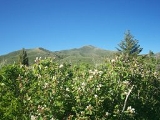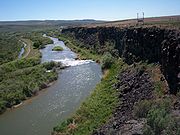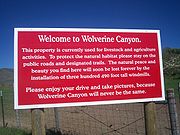
Blackfoot Mountains
Encyclopedia
The Blackfoot Mountains, also called the Blackfoot Range, is a small range of mountains located east of Blackfoot
, Idaho
. Most of the area is private property, including the range's tallest mountain, Taylor Mountain. There is more than one mountain in Idaho named Taylor Mountain. This one was named for Sam Taylor, an early settler and brother of Matt Taylor
.Otteson, Connie B. "Unsung Heroes and Settlers of Bonneville County, Idaho". Harris Publishing Company, Inc. 2005.
Nevertheless, a part of Wolverine Canyon, which runs through these mountains, does have a few sites available for hiking, camping and other recreational pursuits.
 This area is mainly a hilly shrub-steppe
This area is mainly a hilly shrub-steppe
, covered in sagebrush
and juniper
. However, there are many springs and small streams which form microclimates
with more water-loving plants.
The mountains themselves are mainly basalt
.
wind farm on the range, built (and later sold off) by Ridgeline Energy, LLC. That company received a Special Use Permit from the Bingham County Planning and Zoning Commission on April 24, 2008 to build 150 more turbines on the Goshen South wind farm. It is predicted that these turbines will supply up to 450 megawatts of electricity.

 There is some opposition to the project because of the fear it will interfere with the area's natural beauty. The turbines are planned to be built on property owned by local rancher Kelly Bingham, who claims that the new turbines will not be visible by people enjoying Wolverine Canyon's recreational aspects. Nevertheless an appeal was filed against the April 24 decision by a group of local landowners, including former state legislator Stan Hawkins and local business man, Frank L. VanderSloot. Mr. VanderSloot said of the proposal, "It's an atrocious idea. There is a place for windmills, and (wind energy) is a very good idea, but it's in very much the wrong place." The appeal noted a number of problems with the project:
There is some opposition to the project because of the fear it will interfere with the area's natural beauty. The turbines are planned to be built on property owned by local rancher Kelly Bingham, who claims that the new turbines will not be visible by people enjoying Wolverine Canyon's recreational aspects. Nevertheless an appeal was filed against the April 24 decision by a group of local landowners, including former state legislator Stan Hawkins and local business man, Frank L. VanderSloot. Mr. VanderSloot said of the proposal, "It's an atrocious idea. There is a place for windmills, and (wind energy) is a very good idea, but it's in very much the wrong place." The appeal noted a number of problems with the project:
Blackfoot
The Blackfoot Confederacy or Niitsítapi is the collective name of three First Nations in Alberta and one Native American tribe in Montana....
, Idaho
Idaho
Idaho is a state in the Rocky Mountain area of the United States. The state's largest city and capital is Boise. Residents are called "Idahoans". Idaho was admitted to the Union on July 3, 1890, as the 43rd state....
. Most of the area is private property, including the range's tallest mountain, Taylor Mountain. There is more than one mountain in Idaho named Taylor Mountain. This one was named for Sam Taylor, an early settler and brother of Matt Taylor
James Madison Taylor
James Madison Taylor, better known as Matt Taylor, was an early settler of southeastern Idaho. He built a toll bridge over the Snake River at Black Rock Canyon. Idaho Falls was eventually established at the site of this bridge...
.Otteson, Connie B. "Unsung Heroes and Settlers of Bonneville County, Idaho". Harris Publishing Company, Inc. 2005.
Nevertheless, a part of Wolverine Canyon, which runs through these mountains, does have a few sites available for hiking, camping and other recreational pursuits.
Ecology

Shrub-steppe
Shrub-steppe is a type of low rainfall natural grassland. Shrub-steppes are distinguishable from deserts, which are too dry to support a noticeable cover of perennial grasses or other shrubs, while the shrub-steppe has sufficient moisture levels to support a cover of perennial grasses and/or...
, covered in sagebrush
Artemisia tridentata
Artemisia tridentata is a shrub or small tree from the family Asteraceae. Some botanists treat it in the segregate genus Seriphidium, as S. tridentatum W. A. Weber, but this is not widely followed...
and juniper
Juniper
Junipers are coniferous plants in the genus Juniperus of the cypress family Cupressaceae. Depending on taxonomic viewpoint, there are between 50-67 species of juniper, widely distributed throughout the northern hemisphere, from the Arctic, south to tropical Africa in the Old World, and to the...
. However, there are many springs and small streams which form microclimates
Microclimate
A microclimate is a local atmospheric zone where the climate differs from the surrounding area. The term may refer to areas as small as a few square feet or as large as many square miles...
with more water-loving plants.
The mountains themselves are mainly basalt
Basalt
Basalt is a common extrusive volcanic rock. It is usually grey to black and fine-grained due to rapid cooling of lava at the surface of a planet. It may be porphyritic containing larger crystals in a fine matrix, or vesicular, or frothy scoria. Unweathered basalt is black or grey...
.
Wind turbine controversy
There is already a 65 megawatt, 43-turbineWind turbine
A wind turbine is a device that converts kinetic energy from the wind into mechanical energy. If the mechanical energy is used to produce electricity, the device may be called a wind generator or wind charger. If the mechanical energy is used to drive machinery, such as for grinding grain or...
wind farm on the range, built (and later sold off) by Ridgeline Energy, LLC. That company received a Special Use Permit from the Bingham County Planning and Zoning Commission on April 24, 2008 to build 150 more turbines on the Goshen South wind farm. It is predicted that these turbines will supply up to 450 megawatts of electricity.


- Power production should not be allowed in an area set aside for agricultural use.
- The application for the conditional-use permit didn't contain a site plan drawing.
- The planning commission limited the amount of time individuals could testify at public meetings.
- The turbines could be placed on another, less valuable site.
- Construction of the machines would drive off wildlife and destroy big-game habitat.
- Erection of the turbines would cause a huge loss to a historical site.

